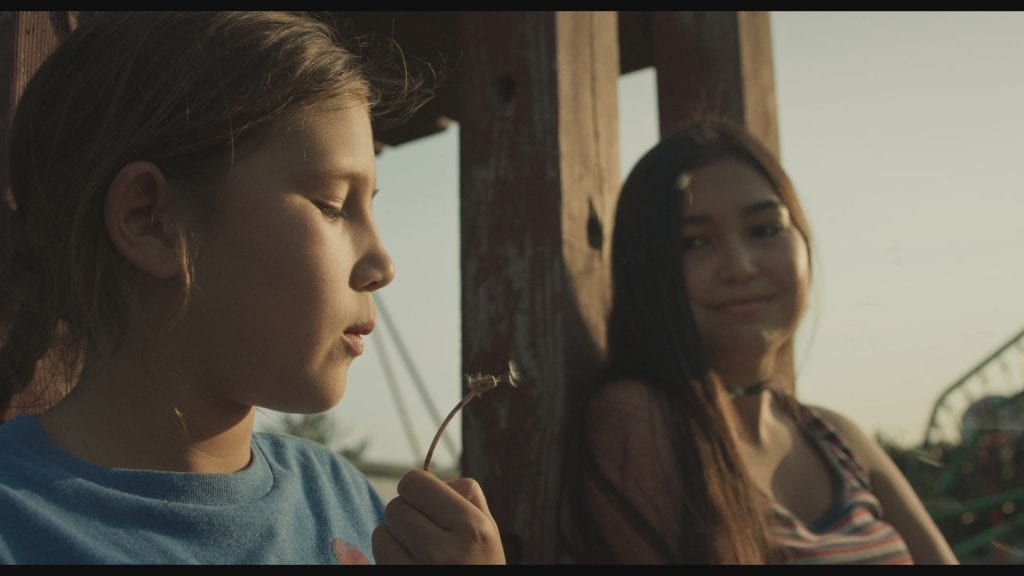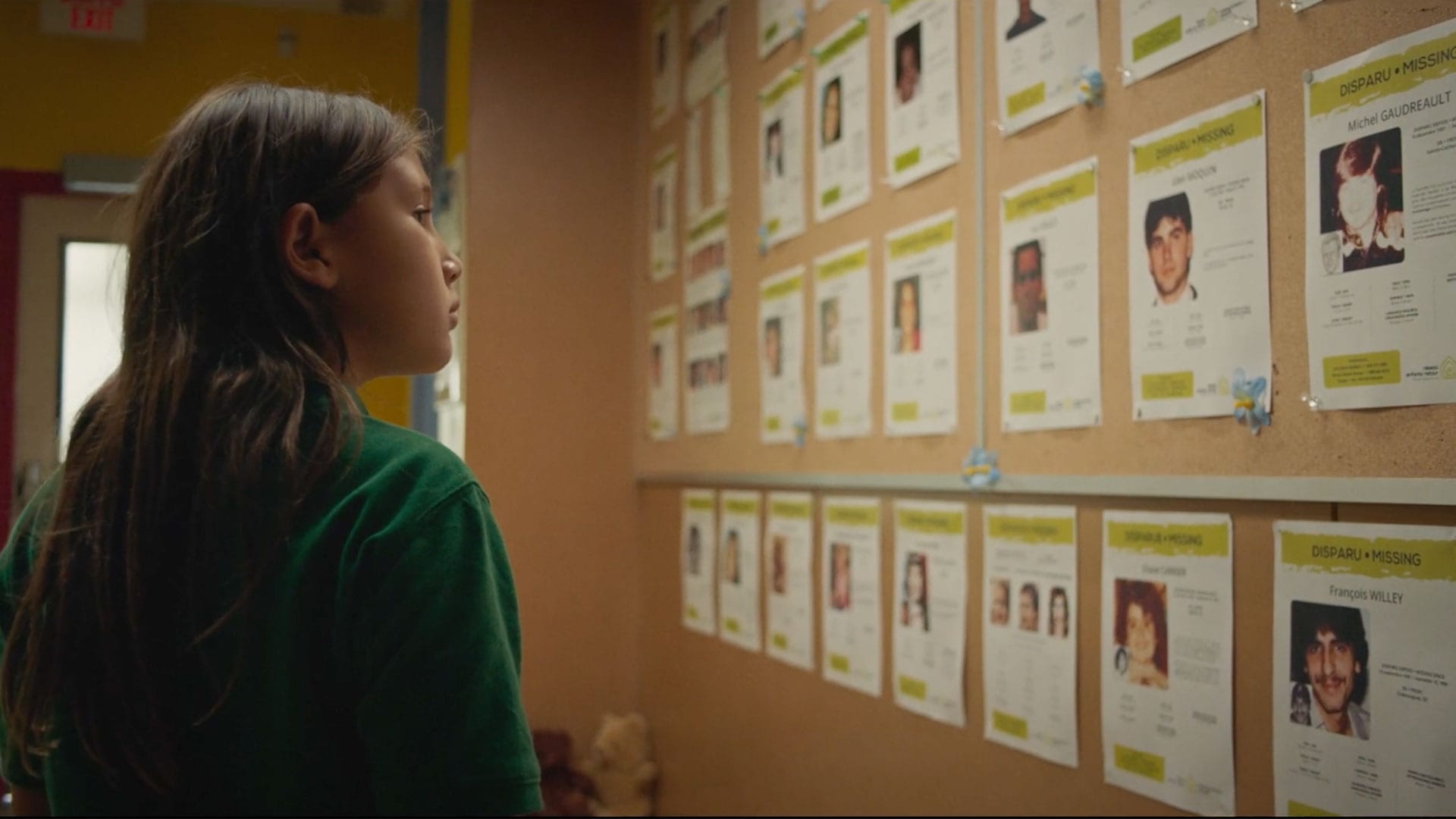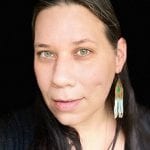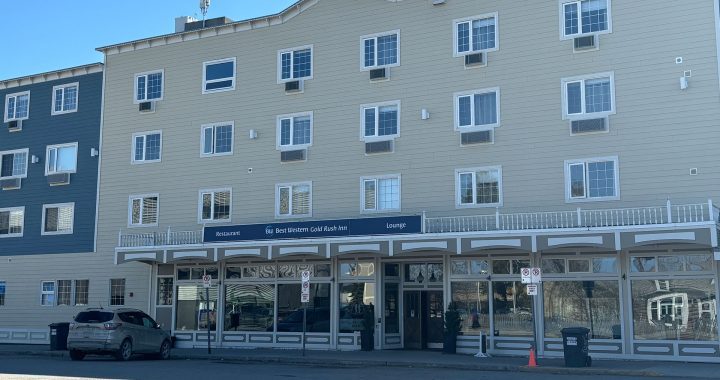
Lake Kahentawaks Delisle (as young Ivy) and Mckenzie Kahnekaroroks Deer (as Heather) in the film Rustic Oracle. Photo Credit: Nish Media.
Award-winning Mohawk filmmaker Sonia Bonspille Boileau, (Le dep, The Oka Legacy, Last Call Indian), is premiering her latest film Rustic Oracle this week in Nanaimo and Kelowna.
“I wrote Rustic Oracle a few years ago,” Bonspille Boileau says. “Like so many Indigenous people in the country, I was heartbroken by stories that were coming out of Missing and Murdered Indigenous Women (and Girls).
“I was attending vigils and walks, and it became really overwhelming. And usually what I do with stories that bother me and when I can’t sleep well, I turn those things into content, film.”
Boileau is from Kanehsatà:ke Mohawk Nation, a small community, about 45 minutes west of Montreal. Most Canadians know it as the village where the siege of Kanehsatà:ke (Oka Crisis) happened in 1990.
For her, the issue of missing and murdered Indigenous women and girls (MMIWG) came into focus in 2008.
“In 2008, in my partner’s community of Kitigan Zibi, two teenagers went missing, Maisy Odjick and Shannon Alexander,” she says.
“I saw what it did to the community… and how there was not much interest from the general media or general public to actually help these families find them. That really bothered me.”
Rustic Oracle follows the story of a missing teenage girl, told through the eyes of her seven-year-old sister.
The story unfolds as young Ivy accompanies her mother Susan on a road trip with the hopes of finding her older sister who suddenly disappeared from their First Nation community.
“The idea of telling the story through the lens of childhood, through Ivy’s eyes… I’m a mom, I was imagining my own kids, how they [would] process that. And that was really hard to do. I broke down crying quite a few times writing the film,” Boileau says.
“When I was writing the script, I drew from many different stories because I specifically didn’t want to put that burden on a family… that pain of reliving exactly like moment for moment, their story on screen.”
In her director’s statement, Boileau explains that this story could have been about her family.
“While Rustic Oracle may not be based on a true story, what happens to Heather is similar to so many stories in our communities. Luckily I did not become a statistic. Today we are constantly made aware of the startling numbers associated with the National Inquiry into Missing and Murdered Indigenous Women (and Girls) and in many ways; I hope that my film sheds light on this social injustice that continues to persist today.”
So far, this film has won 26 awards at national and international film festivals, including two Leo Awards for Best Film and Best Lead Performance.
Rustic Oracle features a predominantly Indigenous cast and crew – including writer/director, producer and production team.
On Sept. 25, the film is making its Western Canada premiere in Nanaimo and Kelowna.
A conversation with Sonia Bonspille Boileau:
IndigiNews: What was it like for you on a personal level to make this film?
Sonia Bonspille Boileau (SBB): It’s probably the hardest project I’ve ever worked on so far, especially in the development phase, getting the story right. And realizing that, so many people that I love, could be a statistic right now. There are so many times that as I’m writing, I realize how heartbreaking it is to write the words.When we were rehearsing, hearing the words for the first time was very emotional for myself, but also for the actors.
Luckily though, I was surrounded by so many wonderful people and the actors were surrounded by many people as well. There were a lot of Indigenous women on set. I made sure that I hired as many Indigenous women as possible, both in front and behind the camera. We were there for each other. We allowed each other to have those moments when it became overwhelming, we provided both time and space for us to live our real emotions.
The key to pushing through the hard scenes was having the community members with me to tell the story, that helped. And in the edit, it’s really weird because as you go through you’re still trying to make a compelling, good movie. And then you’re torn between what feels too hard or too harsh. So you’re struggling between what you, as a person don’t really want to live through or see. And the filmmaker’s side who really wants to tell a good story, to make a good movie. So I found that part in editing a bit of a struggle.
During the shoot, there are a couple of scenes where Ivy [played by actor Lake Delisle] breaks down crying and just shooting those. I felt really bad, making a little girl cry. Even now, when I think about it, I still get a little choked up at the idea of it but then I know that those are some of the more powerful scenes in the film. Luckily I had Lake’s mom with me, reassuring me and telling me that it was okay. It’s also part of her own process and she wants to be able to help tell this story. So in the end it was all good. And I’m glad we did it, but in the process, it was quite hard.

IndigiNews: Did you have these discussions with people during the casting process?
SBB: Lake is also Kanien’kéha:ka, Mohawk and she was absolutely amazing. Before officially offering the role of Ivy to her, I met with her mom and made sure that she understood the vision, the reasons why we were doing it. Lake’s mom explained to me that Lake is very aware of the problem of MMIWG. In Kahnawà:ke, they knew a woman that sadly was murdered a few years back. And so, she has a connection to the subject that goes beyond just knowing about the overall Canadian problem. So for them, there was a personal reason to tell this story with me.
For the tough scenes, Lake has an older brother that she looks up to and she loves so dearly. She told me imagining him going missing was enough to bring her to tears.
So she drew from what she’s living and how she would process things. That was so incredibly heartbreaking, but very mature for her age to think of that.
I wouldn’t have told a story through the lens of a child without the parents being there throughout the entire process.
IndigiNews: Why does telling this story matter?
SBB: It matters, there are many non-Indigenous people in this country that are not aware of the problem, or don’t see human faces behind the numbers.
There’s something very powerful in seeing resilient, strong, complex Indigenous characters. That’s really important, to see ourselves as strong people that are pushing through hardship. For many years, I longed to see strong Indigenous women on screen.
Film, art and media, they’re not just art forms. It actually shapes our culture, which shifts our collectiveness, the way that we see society. If I can have a tiny, little impact, and shift the way we see Indigenous women, that’s all I wanted to do with film.

IndigiNews: Often the lives and experiences of MMIWG have been silenced. How do you think telling the story will help that?
SBB: What was really important for me, was to show that it’s not just marginalized people that become victims of violence. There was still this overall judgement, prejudice or misconception of MMIWG. That they are all women with a troubled past, who didn’t have a supportive family or community.
This can happen to any family. I think it was important to show Heather’s family, she came from love. Her mom was a loving human being that obviously still carried her own trauma. Like we all do, but she was still a good mom.
IndigiNews: How does making these stories help the families and people impacted?
SBB: The sad reality is when you don’t have answers, you still have to carry on in life. I wanted to show how I am in awe with all these mothers and the siblings who find strength to do that.
I really wanted non-Indigenous people to understand and not just see MMIWG as statistics. I want them to see there are entire families that are still grieving and still looking for answers.
In the beginning I toured with the film in different festivals. There are so many families that opened up after the film, publicly in front of the audience. They started speaking of their own personal connection to the story; or to me personally, at the end of the screening.
And I realized how watching the film does open up these wounds or these tragedies. I felt really bad, but then I realized that there was something cathartic about it. Something soothing to be able to share, in not only a safe space; but to identify with these stories and realize that they’re not alone.
So now, when we do tour again with the film and go into communities, we’re going provide healthcare workers and people that are more equipped than I am to actually receive those stories and to make sure that they have the right answers.
IndigiNews: Can you tell me a little more about your writing process. It sounds like it was emotionally hard work at times. What was your backup and support?
SBB: have a super supportive hubby/ producer. He’s my producer, but he’s also my partner in life. He knows when I’m writing a hard scene. He’ll take the brunt, do more with the kids at home, or with our other projects.
After this next project, I’m going to need to take a break from hard, tough subjects that are too real, because it is getting to me.
It would be really nice for Indigenous people to see a story that’s not rooted in trauma or pain. If we had access to more funding, opportunities, platforms and windows to showcase our art and storytelling talent, maybe we wouldn’t feel the need to talk only about the really hard subject matters. There aren’t that many Indigenous films out there from our perspective.
When we have addressed the main core issues of many of our social problems; then we can just make films, not necessarily having to have the fist up at the same time. We’ll have that liberty that so many other Canadian filmmakers have, of just telling a good story without feeling that this might be the last story that we get to tell.
IndigiNews: The film premieres in Kelowna and Nanaimo this week, how are you feeling?
SBB: I’m super excited because honestly, we weren’t even supposed to have a West coast theatrical release. When the theaters started reopening, they didn’t have many films to actually play because most American big block blockbuster films were delayed. And that’s when theaters started noticing this little Canadian, independent film that’s doing really well at festivals.
IndigiNews: What do you hope people take away from the viewing?
SBB: I hope people see the absolute strength in Indigenous mothers. And I hope people, especially the non-Indigenous viewers, see how much we actually have in common as human beings, as people with families. And I’m hoping that if people are touched by this story, that they’ll want to learn more about so many other stories that have happened, and are still happening in Canada. There’s power in awareness, to actually create meaningful change for the future.










